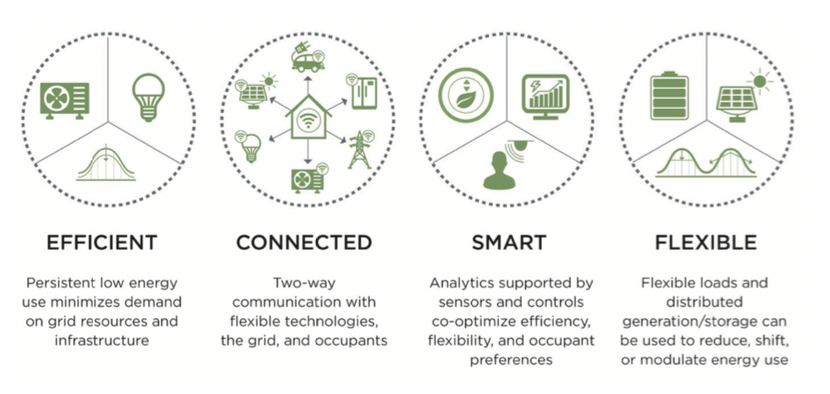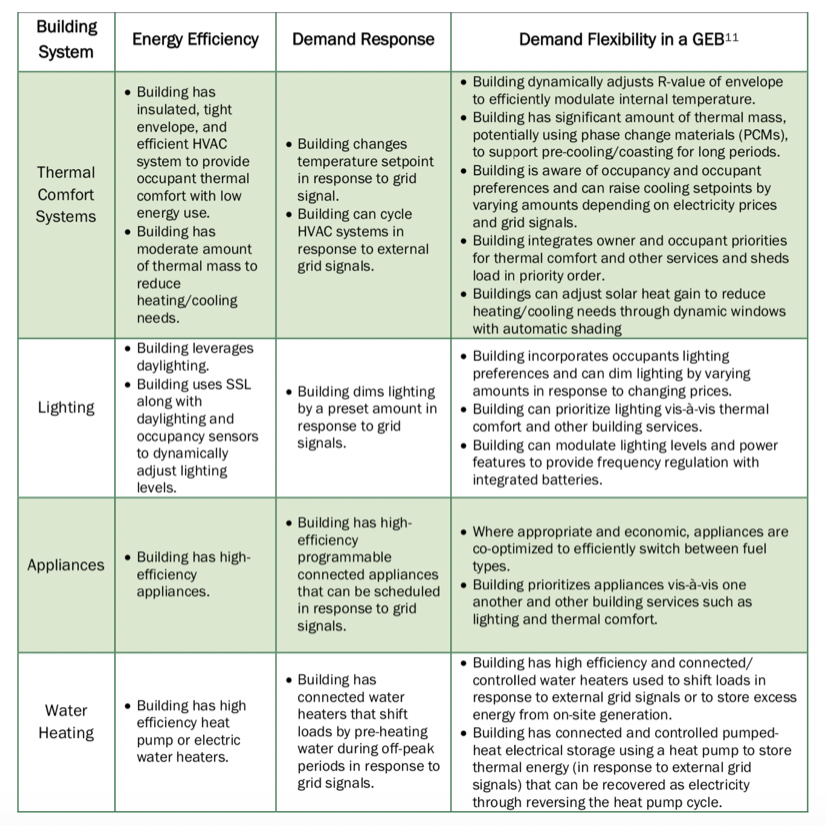Grid-interactive Efficient Homes
New ResidentialWhat are Grid-interactive Efficient Homes?
A Grid-interactive Efficient Home refers to an energy efficient home with smart technologies (e.g., smart meters, appliances, sensors and controls) designed to utilize multiple distributed energy resources (DERs) including solar photovoltaic (PV), wind, energy storage, demand response (DR), electric vehicles (EVs), microgrids, and energy efficiency in an integrated way to optimize energy use for grid services (i.e., generation, transmission, and distribution of electricity from utility to consumer) and occupants.[1]
Figure 1 shows several key features of GEBs. They are energy-efficient with high-performance features designed to reduce both net energy consumption and peak demand. Second, they are connected, with two-way communication capabilities that allow for response to grid conditions. Next, they are also smart with sensors and controls to optimize energy use for occupant patterns and preferences, utility price signals, weather forecasts, and available on-site generation and storage. Finally, they are flexible with the ability to reduce, shed, shift, modulate or generate electricity.

Figure 1 – Grid-interactive Efficient Building Key Characteristics (Source: U.S. DOE Grid-interactive Efficient Buildings 2019).
Traditional homes do not interact with the grid or exchange energy data information. Smart homes with advanced sensors and controls, and connected devices can utilize a variety of distribute energy resources (DERs) but often manage them separately. For example, smart metered homes employ advanced meters that record and communicate electricity consumption in short-time intervals back to the utility, providing two-way communication, support for advanced monitoring and payment systems, and remote disablement and enablement of supply (see Smart Meters).[2] Smart metered homes with on-site renewable energy generation (see Photovoltaic Systems and On-Site Wind Energy Generation Systems) and energy storage (see Energy Storage and Back-up Power Generation) can signal consumers to use renewable electricity when available, store excess when not needed or sell excess electricity to the grid. Electric vehicles can provide energy storage for energy generated on-site or from the grid when electricity demand is low (see Alternative Transportation).[3] Demand response ready devices and appliances can be automatically controlled by energy providers or incentivized through demand response programs to motivate consumers to reduce or shift energy use to off-peak hours.[4]
Grid-interactive Efficient Buildings (GEB) move beyond the siloed smart home approach to integrate across DERs, managing interactions and benefiting from synergies. Table 1 illustrates the integrated approach of GEB. In this example, grid-interactive efficient homes is the sum (i.e., integrated DER approach) of the energy-efficiency and demand response columns (i.e., single DER approaches) and the additional capabilities of the GEB column.
Table 1 – Single vs. Integrated Distribute Energy Resources (DER) Approach

Table 1 – Single vs. Integrated Distribute Energy Resources (DER) Approach Source: US DOE Office of Energy Efficiency and Renewable Energy: GEB Overview. 11 Note: GEB is meant to be additive of EE and DR columns- GEB is the sum of efficiency, demand response, and the additional capabilities listed in the GEB column.
Implementing a Grid-interactive Efficient Home
Implementing a Grid-interactive Efficient Home starts with optimizing energy efficiency, assessing DER opportunities and utilizing smart building technologies, which typically include installation of metering devices, communication networks, and data gathering and processing systems, as well as associated management and installation requirements.
The decision to install smart sensors and controls and the type of technologies selected depends on the size of the home and the occupants user profile. Smart system set-up and installation requires expert assistance. Look for devices with interoperability between smart home technologies and with demand response functionality to allow for changes and updates over time as new products, services and incentive programs become available.
While sensors and controls may require cabling and cable pathways, an increasing number of applications now offer wireless capabilities. While sensors that do not depend on external power are available and recommended, sensors and controls that do rely on the grid and network connections require backup options for electric power and network connection in case of a power or network failure.
Contact the NJ Office of Clean Energy to learn about current incentives and programs that support smart building technologies that increase energy-efficiency.
Example
Connected Neighborhoods Project
The Connected Neighborhoods Project recognizes the opportunities for maximizing building-to-grid interaction across a set of buildings. The first Smart Neighborhood, located in Birmingham, Alabama, is a joint project between Alabama Power, Signature Homes, and researchers at Southern Company, U.S. Department of Energy’s Oak Ridge Laboratory and the Electric Power Research Institute. This project integrates 62 high-performance homes with energy efficient systems and smart technologies, and a community-scale microgrid with PV panels, battery storage, and a backup natural gas generator to optimize grid services, cost savings, and resiliency.
Benefits
GEBs provide benefits to the grid by shifting energy loads to off-peak times with more efficient generation from renewable sources thus reducing the need for additional generation from expensive standby power plants, and resulting air pollution, and preventing supply interruptions, grid congestion, and line losses.[5] GEBs also help to balance new loads such as electric vehicles (EVs) and to support the electrification of transportation by hosting two-way EV charging locations. Also, GEBs can provide utilities with information for conducting load forecasting, tracking renewable energy generation and storage, providing better monitoring of service quality, improving management of service outages, and initiating demand response programs.[6]
GEBs add value to homeowners by transforming traditional but flexible building energy demands like lighting and HVAC, along with DERs into energy assets.[7] GEBs equipped with smart technologies can respond to electric grid conditions, which helps avert system stress, enhancing the reliability of the entire grid. For homeowners, the benefits include cost-savings and efficiency gains from a better understanding of energy consumption patterns, advanced load and asset control mechanisms, and increased demand response and DER opportunities.
Costs
The initial cost, energy savings, and payback of GEB varies depending on the home’s technological features, size, layout, and existing capabilities. In general, whole building applications benefit from economies of scale and cost less to install per square foot in larger buildings than in smaller ones. Advances in wireless technologies have also lowered installation and commissioning costs compared to wired devices. Savings from the reduced utility demand charges often help cover the costs of building automatic systems and smart sensors and controls.[8]
Resiliency
GEBs increase resiliency by supporting the smart grid, which aims to diversify and strengthen the electric grid through better energy management and the integration of cleaner energy sources such as wind and solar as well as electric vehicle charging into the electric grid. During storms or power outages, GEBs help accelerate service restoration by identifying problem areas and efficiently dispatching work crews, thereby reducing repair costs and total outage times, limiting business closures, health and safety hazards, food spoilage, and inconvenience from schedule disruptions. [9]
[1] U.S. DOE Office of Energy Efficiency & Renewable Energy. April 2019. Grid-interactive Efficient Buildings: Overview https://www.energy.gov/sites/prod/files/2019/04/f61/bto-geb_overview-4.15.19.pdf (accessed April 29, 2019).
[2] Connected Devices Alliance (CDA). 2018. “Intelligent Efficiency – A Case Study of Barriers and Solutions – Smart Homes.” March 2018. https://edna.iea-4e.org/news/case-study-smart-homes (accessed August 17, 2018).
[3] Ibid.
[4] Smart Home. Home Automation Buying Guide. https://www.cnet.com/news/smart-home-buying-guide-home-automation/ (accessed May 3, 2018)
[5] Connected Devices Alliance. 2018. “Intelligent Efficiency – A Case Study of Barriers and Solutions – Smart Homes.” March 2018.
[6] 2006 FERC Report, 18 http://www.ferc.gov/legal/staff-reports/demand-response.pdf (accessed May 1, 2018).
[7] U.S. DOE Office of Energy Efficiency & Renewable Energy. April 2019. Grid-interactive Efficient Buildings: Overview https://www.energy.gov/sites/prod/files/2019/04/f61/bto-geb_overview-4.15.19.pdf (accessed April 29, 2019).
[8] EPRI. “Estimating the Cost and Benefits of the Smart Grid.” https://www.smartgrid.gov/files/Estimating_Costs_Benefits_Smart_Grid_Preliminary_Estimate_In_201103.pdf (accessed May 5, 2018).
[9] DOE. “Smart Grid Investments Improve Grid Reliability, Resilience, and Storm Responses.” https://www.smartgrid.gov/files/B2-Master-File-with-edits_120114.pdf (accessed May 1, 2018).
Related Strategies
Resources
- GRIDWISE ALLIANCE
- New Buildings Institute (NBI) GridOptimal Buildings Initiative
- NJ Office of Clean Energy
- NREL Electric Vehicle Grid Integration
- Smart Energy Consumer Collaborative
- SmartGrid.Gov
- Smart Grid – Where Power is Going?
- US DOE Office of Energy Efficiency & Renewable Energy. Grid-interactive Efficient Buildings
